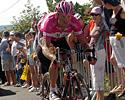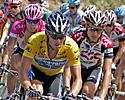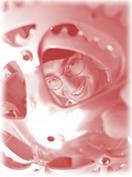
Recently on Cyclingnews.com |
|
|
View from the lab - Ric Stern's Tour de France sports science
British ABCC coach Ric Stern (www.cyclecoach.com) is a regular contributor to Cyclingnews' Form & Fitness section along with being a full time coach. Still an active rider when time allows, Ric will be providing a physiological insight into the challenges that face the riders in the Tour.
July 21, 2005: High intensity and fatigue

|
A very tough stage in the Massif Centrale with numerous unclassified climbs and quite a few classified climbs, plus the leg sapping climb to the finish where Marcos Serrano won the stage. Due to this stage coming after the Pyrenees and the Alps it was always likely to favour a small breakaway group. The constant ups and downs of the road make this type of stage difficult for the riders, especially when they are fatigued.
The shortness of the hills allied to their steepness means that the intensity will be possibly somewhat higher than a longer climb where the riders can settle into a lower intensity. It's well known that intensity is inversely related to duration, and therefore the shorter climbs are ridden at a higher intensity than the longer ones.

|
The riders in the break would have had to work hard and share the workload as much as possible to enable the break to stay away. Of course, when a huge lead occurs as happened in stage 18 (and a couple of other stages) riders can ease off a little, as it's highly unlikely the peloton would come back to them. This type of scenario tends not to happen in amateur racing, as the style of racing is different.
When the main group hit the finish climb, the race splintered because of attacks from Ivan Basso. In this final breakaway of the stage we saw a select four-man group fight it out on the tough slopes of the Cote de la Croix Neuve. In the group were Basso, Cadel Evans, Lance Armstrong and Jan Ullrich. Seconds behind, but missing from the four was highly placed GC riders like Michael Rasmussen, Alexander Vinokourov, Levi Leipheimer and Floyd Landis. Although the time gaps weren't huge - between 37 and 49 seconds for selected riders, it may well be telling in the days to come.

|
On Saturday is the final time trial, and for certain Jan Ullrich will be trying to overhaul Michael Rasmussen for a place on the podium. Although it was possibly already likely that Jan would take maybe several minutes out of Michael, yesterday's stage shortened the time gap between third and fourth place from 2.49 minutes to 2.12 minutes. When you're highly placed on the general classification it's always important to try and maintain your position and not lose time, where at all possible. Of course, if Rasmussen does lose his third place position to Ullrich, he will still be on the podium (as the King of the Mountains).

|
As the leaders hit the final climb it takes them around 8 minutes to climb this steep brute. With such a short (compared to the Alps and Pyrenees) climb, the intensity on this climb could have been quite close to VO2max for these riders - especially as the GC four were really going for it. On the longer climbs the riders would have been closer to their sustainable maximum power (when, for example, climbing the last mountain of the day). Today it's closer to VO2max. Another very tough day of riding, and the riders will need to dig deep to maintain a high overall position or go for a stage win. There are no gifts in the Tour even when you'd be expecting them to decrease their efforts because of excessive fatigue.
2005 entries - the Tour de France
- July 28 - Stage 21 - What it takes
- July 23 - Stage 20 - Getting the TT right - and wrong
- July 22 - Stage 19 - The perfect break
- July 21 - Stage 18 - High intensity and fatigue
- July 19 - Stage 16 - Maintaining an attack
- July 17 - Stage 15 - Tour's biggest day
- July 16 - Stage 14 - Attacks keep coming
- July 15 - Stage 13 - Positive thoughts
- July 14 - Stage 12 - Hot, hot, hot!
- July 13 - Stage 11 - Big efforts uphill
- July 12 - Stage 10 - Number crunching
- July 7 - Stage 6: The dynamics of a breakaway
- July 6 - Stage 5: Coming back after a TT
- July 5 - The TTT - Man, machine and team
Previous Cyclingnews features by Ric Stern
- Winter Training
- Weight training and cycling - The Great Debate
- Power zone training - How to set training levels with a power meter
- Ric Stern also answers Cyclingnews readers' questions in our Form & Fitness Q&A section

